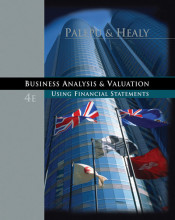Summary: Business Analysis And Valuation: Using Financial Statements | 9780324302929 | Krishna Palepu, et al
- This + 400k other summaries
- A unique study and practice tool
- Never study anything twice again
- Get the grades you hope for
- 100% sure, 100% understanding
Read the summary and the most important questions on Business Analysis and Valuation: Using Financial Statements | 9780324302929 | Krishna Palepu; Paul Healy
-
2 Tekst 4.1 Overview of accounting analyses blz. 10-24
This is a preview. There are 40 more flashcards available for chapter 2
Show more cards here -
What helps to ensure that performance metrics are calculated using comparable definitions?
Recasting the financial statements using a standard template, helps ensure that performance metrics used for financial analysis are calculated using comparable definitions across companies and over time. -
What is used to identify whether there have been any distortions to assets, liabilities, or shareholders' equity?
A balance sheet approach. Once any assets and liability misstatements have been identified, the analyst can make adjustments to the balance sheet at the beginning and/or end of the current year, as well as any needed adjustments to revenues and expenses in the latest income statement. -
Describe the classification by nature.
The classification by nature defines categories with reference to the cause of operating expenses. Firms using this classification typically distinguish between the cost of materials, the cost of personnel and the cost of non-current assets (vaste activa) such as depreciation and amortisation. -
Describe the classification by function.
The classification by function defines categories with reference to the purpose of operating expenses. Costs that are incurred for the purpose of production the products or services sold (cost of sales) and costs for overhead activities such as administrative work and marketing (Selling, General and Administrative Expenses (SG&A)). -
What do firms have to disclose in their first IFRS based financial statements?
To illustrate the effects of IFRS adoption on their financial figures firms have to disclose in their first IFRS based financial statements:- A description of the sources of differences between equity reported under previous accounting standards and under IFRS as well as the effects of these differences in quantitative terms.The firm must provide such reconciliations for equity in both its opening and its closing comparative balance sheets.
- A reconciliation of net profit reported under previous accounting standards and under IFRS for the prior year.
-
What is the basic principle on lease accounting?
When a lessee (huurder) carries substantially all the risks of a leased asset, the asset is essentially owned by the lessee and must be reported on its balance sheet. -
When is a firm permitted (toegestaan) to recognise revenues?
Firms are permitted to recognise revenues only when the product has been shipped or their service has been provided to the customer. Revenues are then considered earned, and the customer has a legal commitment to pay for the product or service. -
Ambiguity over whether a company owns an asset creates a number of opportunities for accounting analyses, which are they?
- Financial statements sometimes do a poor job of reflecting the firm's economic assets because it is difficult for accounting rules to capture all of the subtleties associated with ownership and control.
- Accounting rules cannot always prevent important assets being omitted from the balance sheet even though the firm bears many of the economic risks of ownership.
- There may be legitimate differences in opinion between managers and analysts over residual ownership risks borne by the company, leading to differences in opinion over reporting for these assets.
- Aggressive revenue recognition, which boosts reported earnings, is also likely to affect asset values.
-
What are the two ways in which a firm can record its leased assets?
- Operating method (rental contract). The firm recognises the lease payment as an expense in the period in which it occurs, keeping the leased asset off its balance sheet.
- Finance method (equivalent to a purchase). The firm records the asset and an offsetting lease liability on its balance sheet. During the lease period, the firm then recognises depreciation on the asset as well as interest on the lease liability.
-
IAS 17 explains that a firm would normally consider a lease transaction equivalent to an asset purchase if any of the following conditions hold, which are these conditions?
- Ownership of the asset is transferred to the lessee at the end of the lease term.
- The lessee has the option to purchase the asset for a bargain price at the end of the lease term.
- The lease term is for the major part of the asset's expected useful life.
- The present value of the lease payments is equal to substantially all of the fair value of the asset.
- The asset cannot be used by other than the lessee without major modifications.
- Higher grades + faster learning
- Never study anything twice
- 100% sure, 100% understanding

































